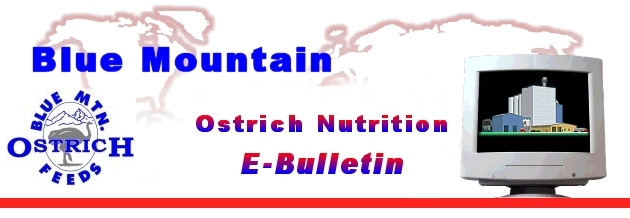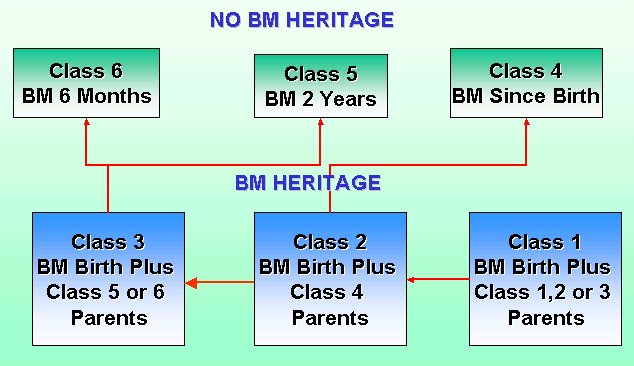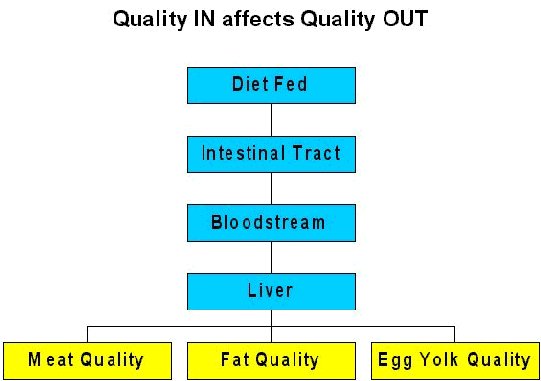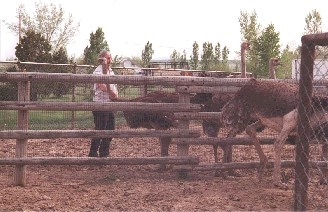

December 5, 2002
Bulletin #87
Table of contents:
Bulletin of the Month
Ostrich Genetics and Nutrition
By: Fiona Benson, Blue Mountain International
Our e-mail address
Subscribe – Unsubscribe information
Bulletin of the Month
Ostrich Genetics and Nutrition
An important element of production livestock agriculture is genetic improvement programs. With ostrich, the only major improvement program occurred 100 or so years ago when a few South Africans brought birds from North Africa to improve the feather quality. Over the past 15 years there has been a tremendous amount of bird trading across International boarders. So long as there were feathers and the bird was 2 meters (6.5 feet) tall, there was a value.
Traders have sold birds with statements regarding the different types. Such as:
African Blacks are the only acceptable skins-
- Blues are better meat birds
- Reds are bad tempered
- The Skins of Blues were useless
These statements and assumptions are made with little or no factual evidence to support such statements. Then there have been the “fancy names” that were used only as part of different sales campaigns such as:
Namibian Super Blues-
- Texas Super Blue
Again statements made to assist in sales by tempting buyers. With so much trading, there has been little or no performance records available to enable buyers to purchase birds with genetic tracking in the same manner we have become accustomed to with other livestock production species.
When I returned to England in 1997, after becoming involved in the Ostrich Industry, I was looking forward with interest to seeing Blues and Reds as we only have Blacks in South Africa. It was a shock when I found many birds I was being told had been sold as Reds or Blues were, in many cases, smaller than my blacks back home. This was my first experience of the significant impact of different nutritional programs and recognition of the fact that, until the nutritional factors are taken out of the equation, it is impossible to determine which breed is better than any other. Until the nutritional factors are taken out, it is impossible to see the true genetic performance. It was this experience that instigated my research into Ostrich nutrition that resulted in my association with Blue Mountain.
This bulletin will focus on the importance of nutrition and management issues and how they relate to a meaningful genetic improvement program.
At all times you hear Blue Mountain reference the management factors that influence production in the following order:
1. Production Nutrition
2. Production Feed Management
3. Production Farm Management
4. Production Genetics
The reason for this is that if No.1, Production Nutrition, is not in place, it matters little how good the Feed Management and Farm Management are. The inherent genetic performance cannot show through. Conversely, even with the best nutrition, if the Feed Management and Farm Management are of a poor standard, it is still not possible to have a meaningful genetic improvement program.
Production Nutrition
A summary of all the elements required for production rations are covered in Bulletin No. 83. This bulletin will discuss the influence of nutrition on genetic performance. This is especially relevant with Ostrich Production at this time as there are some extremely poor feeds around the world. Past bulletins have clearly proven this statement:
-
Potential Meat Yield in Ostrich - Bulletin No. 81 demonstrates how the current accepted average growth curve follows a line below that achieved on rations designed for another specie. The bulletin also demonstrates that birds on rations designed specifically for Production Ostrich achieve as much as 50% greater growth than the current accepted norm for Ostrich and in excess of 100% meat yield.
- Influences of Ostrich Skin Quality, Age or Nutrition - Bulletin No. 79 demonstrates the influences on nutrition and management factors on the age of follicle development on the skins. The bulletin proves that acceptable quality can be achieved many months earlier than is the current norm.
- The Welfare of Ostrich and Malnutrition - Bulletin No. 86 proves again the influence of nutrition and the stunted growth that is currently widespread throughout the Ostrich Industry.
- Nutrition and Health - Bulletin No. 80 covers many factors that prove the influence of nutrition on organ development and in particular reproductive organ development and the influence on chick quality.
All the above are important factors in any discussion on Genetic Improvement programs. For example:
·
If reproductive organ development is compromised through poor nutrition, how can a breeder bird perform to it’s genetic potential? This is proven also in papers written by South African researchers reporting only 45% - 60% chicks from eggs and reporting liveweight to the lowest growth curve and carcass weight similar to or lower than meat yields reported Bulletin No. 81 - The Potential Meat Yield of Ostrich.
· Remember the statement: “The liver filters the blood, metabolizes foreign exogenous and endogenous substances, and synthesizes bile, many enzymes and proteins for bodily functions, as well as for the formation of the yolk. It also has a role in many metabolic processes such as carbohydrate utilization and storage.” Therefore if there are many liver problems, how can chicks achieve adequate nutrient transfer to ensure they are strong and healthy at hatch?
If chicks are stunted in their growth, common sense dictates that it must be impossible to determine the true genetic influences?
 |
Blue Mountain receives many messages for assistance and as a result we also see many different rations currently fed in different countries. In the knowledge that the Blue Mountain formulas contain significantly higher levels of nutrients than most others on the market today, we developed a Nutritional Grading system for breeders to enable producers to have an indication of the production potential of their breeders or birds they may be purchasing. (Figure 1) The important factor to understand in this discussion is that the same also works in REVERSE

Figure 1, Nutritional Classifications
The principal of this Nutritional Classification System is that many chicks today are hatched with immature organ development. This is witnessed by the Bright Yellow Livers at the extreme end of breeders receiving insufficient nutrient intake to enable the output of nutrient filled eggs. This is also witnessed by the variable yolk sacs seen at hatch. I have spoken with some vets who have never seen chicks hatched with any bile production which is quite astounding and proof that many do not recognize these malnutrition symptoms. It is important that bile be present in the yolk sac as an essential aid to good digestion of the yolk sac. We see many variations in the size and development of other essential organs also. Clearly if a chick is hatched with these organs not functioning correctly, these chicks are very much slower to progress than chicks hatched with strong healthy organs.
A Class 6 Bird is any bird that has been on BM rations for 6 months. In breeders this provides time for some build up of nutrient levels. The effect on production and chick quality will vary significantly depending on the nutritional history prior to starting on the BM rations with their high nutrient levels and high supplemented vitamins and minerals. In Slaughter birds, it will generally take 6 months to see the full impact of the BM rations to achieve the benefit of the MQSL technology (Meat Quality/Shelf Life Technology) that is built into the rations for quality meat and fat production.
A Class 5 Bird is any bird that has been on BM rations for at least 2 years. By this time Breeders should be capable of providing good nutrient transfer through the egg to the chicks. However, this will also depend on the nutritional history as in many cases the reproductive organs may not have developed as well as they should. In addition, if the previous nutritional program was too poor or low in certain nutrients, permanent damage may have been caused.
A Class 4 Bird is any bird that has been on BM rations from hatch. These birds may have been hatched with immature organs, but with rations high in nutrient value from Day 1, they will have reasonable organ development and have achieved good growth rates.
A Class 3 Bird is any bird hatched from a Class 5 or 6 Breeder. These Birds were hatched from eggs with reasonable egg nutrient transfer. Chicks should be strong at hatch and able to convert feed well from Day 1.
A Class 2 Bird is any bird hatched from a Class 3 or 4 Breeder. These Birds are hatched from breeders capable of providing further improvements in egg nutrient transfer as their reproductive organs had a good chance to develop well.
A Class 1 Bird is any bird hatched from a Class 1 or Class 2 Breeder. This is the stage when the inherent genetics can show through to their full potential. Dramatic improvements in performance have been achieved in Pig Production, Poultry Production, Dairy Production and so on over the last 30 or 40 years. This has been a combination of improvements in Nutrition, the ability to identify the quality genetics and develop a culling policy to remove the poorer performing genetics from the breeder base.
 |

Figure 2, Nutritional Effects on Product Quality
The Production Target tables of the New Ostrich Industry at the end of Bulletin No. 83 should be achievable as herd averages at the end of a 5-year program of Production Nutrition combined with Production Feed Management, Production Farm Management and the commencement of a strong culling program. The culling program will be necessary to identify those breeder birds that are not performing and those breeder birds that produce poor growing chicks. If the program is continued rigorously, at the end of 10 years we predict that the Feed Conversion currently predicted as herd averages for 5-year targets will be halved. That is the untapped genetic potential of Ostrich as a highly productive and profitable livestock production specie.
Further proof that current programs are not working is the fact that no improvements in performance have been achieved in over 100 years of farming Ostriches, or over a decade of farming ostriches outside South Africa. In fact, how many can report reduction in performance? That is the effect of the Nutritional History working in reverse as most rations are well below the nutrient requirements for Ostrich. The factors listed above clearly demonstrate that until the nutritional factors are considered, it is impossible to identify the inherent genetic potential of any bird.
Production Feed Management
Any production nutritional program must be accompanied by Production standards of Feed Management. These are summarised in Bulletin No. 84 .
All profitable livestock production farmers feed their livestock to the highest standards of feed management. Yet with Ostrich we find farmers feeding once a day, some even putting out feed every 3rd or 4th day. A research paper published in the Proceedings of the World Ostrich Congress 2002 referenced feeding the breeders 3 times a week. This is not production livestock agriculture. Ostrich are very susceptible to aroma and less frequent feedings will reduce feed intake. This, by itself, works against good nutrition principles. Once feed is put out, there is also a certain amount of vitamin loss, which increases each day the feed is standing out in the feed troughs.
Before working with the BM formulations, or even aware of the existence of BM, I was feeding my birds 3 times a day. I remember well the comments of the transporters taking the first batch to slaughter commenting on the fact that they did not know that Ostrich could do so well in the climate of the Cape Province. They were also unable to pack as many birds onto the truck due to the fact that they were larger than the average for their ages. Recently at a farmer meeting, one farmer reported that he had started to follow everything written in the book called “Understanding Production Ostrich Nutrition”. He reported immediate improvements in performance. These experiences prove the importance of very high standards of Feed Management and also the ability to improve performance even further despite the fact that the rations being used were not designed for optimum production.
Production Farm Management
Over the years I have visited farms with high standards of feed and farm management, but as the feed is lacking any production characteristics, desired results are not achieved. Production farm management also includes high standards of record keeping. It is essential to track progeny performance to identify the quality genetic breeders and the poor performing breeders. There are some genetics that will never produce high yielding birds.
Figure 3 is a group of Breeders that have been on production rations for most of their lives. Note the contrast in size. “Maggie” is the very small bird in the photo. Her progeny never performed, even when crossed with quality genetic birds. This type of genetic needs to be identified and culled. In contrast, you can see the tremendous strength and depth of the hen in the foreground. Often I have heard farmers report their birds as being tall and therefore believe they are growing correctly. All to often these birds have developed without a good frame. It is the body depth, width and length that is important, not just the height of the birds.

Figure 3, Comparative Genetics
A few years ago a South African scientist told me that the SA farmers couldn’t possibly do production feeding until the genetic base is improved. It is interesting to note that I have received a number of visitors to my farm who made such comments as:
I did not know African Blacks could be so large-
- These birds cannot be Oudtshoorn Genetics as Oudtshoorn birds do not grow to these sizes
- I have never seen birds with so much muscle
- You must be working with superior genetics
My stock came from a commercial Oudtshoorn breeder herd for contract rearing as slaughter birds which clearly indicates these birds are not superior breeding stock. This is clear evidence to me that first you must have the production nutrition in place to be able to identify the superior genetics. It is common sense to me that it is impossible to see the true genetic potential when chicks are slow growing as a result of immature organ development, yolk sacs that do not have the correct nutrients and so on. A chick that has to lose time getting started is losing the period of the most efficient feed conversion period.
Performance Tracking Software
Blue Mountain has now released a Farm Management Software Program that is designed to track progeny performance. The program tracks weight gains, feed intake, feed conversion, feed costs, parentage and many other features. It allows tracking by batch as well as by pen, which enables reporting of progeny from different breeders to be identified even if raised in the same pen as progeny from other breeders. If eggs or chicks are sold, the buyer can report back to the breeder the performance of the progeny. This program can be downloaded at http://www.blue-mountain.net/software/p4.htm and allows 30 accesses to use the program before the need for purchase. This is an essential tool as part of any genetic improvement program.
Conclusion
If your breeders currently have low egg laying, late egg laying, variability in egg weights, low conversion of eggs to chicks, poorer quality chicks at the end of the season, high chick mortalities, these are all symptoms of nutritional deficiencies in the breeder rations. When these nutritional deficiencies are present, common sense dictates that the inherent genetic potential cannot be correctly identified.
If your chicks are hatched with deformities, are slow to get growing, there is high mortality, if you are experiencing yolk sac problems, again these are symptoms of poor breeder nutrition. It is therefore common sense that chicks that are slow to get growing are not only losing valuable time and optimisation of the best period of good feed conversion, it is also not possible to identify accurately the inherent genetic abilities of the birds.
If your slaughter birds are following the growth curve of 1, 2 or 3 in Figure 3 of Nutritional Bulletin No. 81 – Potential Meat Yield of Ostrich, then again common sense dictates that the nutrition is falling short of bringing out the full inherent genetic potential.
All the above, I suggest, prove the importance of nutrition as the foundation to any genetic improvement program.
The End
Click to return to Contents Page
 |
Contact Information:
If you have any Bulletin Topics you would like us to consider for publication in a future E-Bulletin, e-mail your information to
. We are always interested in hearing your ideas about the value of this E-Bulletin, or whether you have any problems viewing this document.
If you would like to discontinue your subscription to this E-Bulletin, or if you have additional e-mail addresses to add to our subscriber list, please visit the following page on our website and use the automated form to “subscribe” or “unsubscribe”: www.blue-mountain.net/feed/bulletin.htm
Also check out our web site at www.blue-mountain.net for feature articles addressing Ostrich Nutrition, Feeding Management, and Ostrich Farm Management.
Click to return to Contents Page
 |
Blue Mountain Ostrich Nutrition E-Bulletin © December 2002
Return to Bulletin Menu